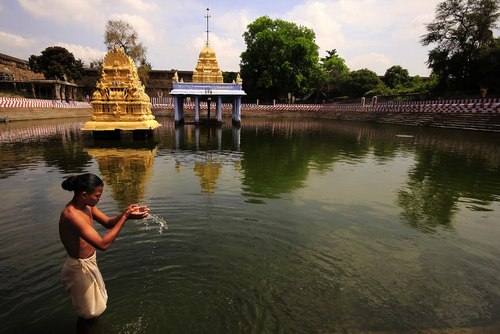Article by Sri Sadagopan Iyengar Swami, Coimbatore
This is an unintended sequel to the earlier two-part posting on the subject, resulting from the clarifications sought by various BhAgavatAs, which enabled adiyen to research deeper into the Smritis and Ahnika Granthas, especially the one by 45th Pontiff of Sri Ahobila Mutt Srimad SrivanSatakopa Sri Narayana Yatindra Mahadesikan.
Is Achamanam prescribed for ladies too? Yes, it is. The difference between the regular Achamanam and that to be done by ladies is that the latter is to be done without the pranava and the chaturtthi. That is, the water is to be sipped thrice, once each with “Achuta, Ananta, and Govinda” only and not “AchyutAya Nama” etc. Also, only these three namas are to be uttered and not the other twelve beginning with “Kesavaya Nama:”
How is the water to be sipped? Water is to be taken for Achamanam via the Deva tIrttham (formed by the joined finger-tips-this is especially when Sandhyavandanam is performed in rivers or tanks), held in the palm which should be in the form of a cow’s ear, and sipped via the Brahma Tirttham(that is, via the bottom of the palm).This is indicated by the Saccharitra Sudhanidhi vachanam “Brahma tIrtthEna nissabdam mAsha magnam jalam pibEt”. This also implies that the intake of water should be without any sound, as occasioned by noisy sucking.
This would necessitate the head to be in a slightly raised position, not of course as raised as for drinking water normally, so that the water comfortably flows down the throat. Incidentally, an Achamanam is supposed to be complete only when the water sipped reaches the heart-it is not enough if it stops with the tongue, palate or even the throat.
“apsu prAptAsu hridayam brAhmaNa; shuddim ApnuyAt”
Though this appears difficult, it should be possible with practice, correct posture of the head, sipping the correct quantity of water, etc.
One more clarification sought was whether the practice of Brihaspatis, not to advise Achamanam at the commencement of various rituals, is correct. Adiyen can only quote the HArIta Smriti-
“Shrouta SmArtEshu gArhyEshu kritEshu vidhivat budha:
dvirAchAmEt tu sarvatra”
This pramANA enjoins upon all to perform two AchamanAs at the beginning of all rituals of all descriptions. A few prescriptions regarding the water used for Achamanam-
Achamanam should not be done using hot water, water with bubbles or froth, mixed with mud or sand, with a foul-smell, that emanating from dirty sources, discoloured water, water perfumed with the addition of cardamom, sandalwood paste, etc., water left over after washing the feet, after Agni kAryam, etc., salty or bitter water, etc. Nor should Achamanam be done with seawater, because the Shruti prohibits drinking of the same- “tasmAt samudrasya na pibanti”.
Why should one touch the various body parts while performing Achamanam? Replies Sage VyAsa- All the DevAs are propitiated by the intake of water with the Achuta, Ananta and Govinda nAmAs. Wiping the lips pleases Ganga and Yamuna, while touching the eyes pleases SuryA and Chandra. Similarly, the AswinI dEvAs are propitiated by touching of the nose, Agni and Vayu by the ears. When the heart is touched with the Padmanabha mantra (which is also the mantra for touching the navel) all the thirty-three crore dEvAs are pleased and the Paramatma by touching the head. The importance of Achamanam can be well understood, when we find it prescribed even as a PrAyaschittam (act of atonement) for all sins. Says Sri BodhAyana in the PrAyaschitta PrakaraNa, “AchamanAdEva sarvasmAt pApAt pramuchyatE”
The purpose of this piece is not to list so many do’s and don’ts that people despair of performing this correctly, but to emphasise the need for due care in this regard, so that any ritual, to which Achamanam is a prelude, is well-begun. And, as everybody knows, well begun is half-done.
“Such a simple act, and so many rules for its performance!” One might wonder: but in view of the apparently boundless benefits to be derived from a single correctly done Achamanam, it is well worth our while to observe the requirements to the maximum possible extent.
Srimad InjimEttu Azhagiasingar, the 42nd Pontiff of Sri Ahobila Mutt, renowned for His erudition and anushttAnam, was reputed to devote great care on every Achamanam He performed, consuming quite a few minutes for the act. And so have several other MahAns of different SampradAyAs, highlighting the significance they attached to this simple, but extremely effective act.
Article by Sri Sadagopan Iyengar Swami, Coimbatore









Swamy,The article on Achamanam by Sri.Sadagopa Iyengar swamy of coimbatore is very informative.Swamy menmelum idumadiri vishayangalai velida Acharya Bhagawan Krupai vendum.
27.01.2014 Dasan
Raghunathan